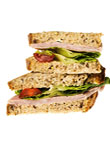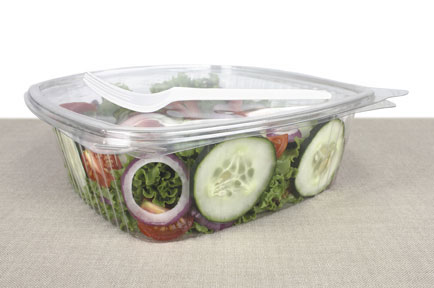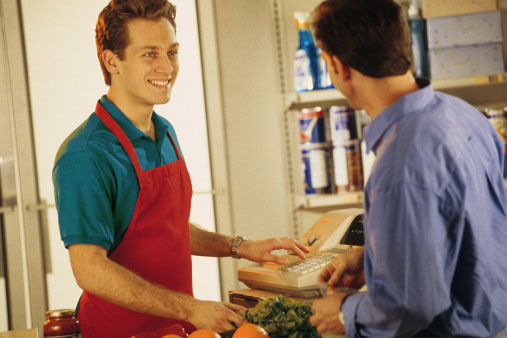 As competition in retail intensifies, the future of the convenience store bottom line is coming into focus: food. Experts and industry advocates say that after decades of selling packaged foods, candy, and maybe the occasional roller hot dog or nacho tray, convenience stores are rapidly breaking new ground in the food service business. They are adding deli counters, salad bars, and even haute cuisine.
As competition in retail intensifies, the future of the convenience store bottom line is coming into focus: food. Experts and industry advocates say that after decades of selling packaged foods, candy, and maybe the occasional roller hot dog or nacho tray, convenience stores are rapidly breaking new ground in the food service business. They are adding deli counters, salad bars, and even haute cuisine.
The only common element uniting the new push for food is the same thing consumers have always relied on convenience stores to provide: speed and convenience. “What convenience stores sell is time,” explains Jeff Lenard, spokesman for the National Association of Convenience Stores. “The future of convenience is food.” This sentiment is echoed by Steve Ryan, executive director of the New England Convenience Store Association. “We see members doing well with food service,” Ryan agrees. “We see salad bowls, fresh sandwiches, pizza ovens, delis. Most convenience stores already sell food, so this is a great way to expand their offerings and provide one-stop shopping. Consumers will see that convenience stores are a great place to get lunch or grab dinner on the way home.”
 Although it might take a little getting used to, there are very good reasons for store owners to move in this direction, according to Lenard. Convenience stores have to deal with high labor costs and low margins for most traditional products. The three main product categories for many convenience stories—beer, cigarettes, and fuel—are all fairly low margin products. The average retail margin on a gallon of gas, for example, is about three cents. Even lottery tickets, another staple product, only have a five or six percent margin.
Although it might take a little getting used to, there are very good reasons for store owners to move in this direction, according to Lenard. Convenience stores have to deal with high labor costs and low margins for most traditional products. The three main product categories for many convenience stories—beer, cigarettes, and fuel—are all fairly low margin products. The average retail margin on a gallon of gas, for example, is about three cents. Even lottery tickets, another staple product, only have a five or six percent margin.
This doesn’t mean, however, that it’s easy to get into fresh food service. Convenience stores that move into prepared foods must, “act like restaurants,” Lenard recommends. One good way to move up the learning curve is to partner with a local fast-service restaurant chain, or even hire a local chef who has an interest in the challenge of creating a novel and interesting dining experience. “You can even poach a local sous chef,” Lenard says. After all, in a world gone crazy for food trucks, who says a food counter at a convenience store can’t take some culinary risks?
Dollar store effect
While there’s little doubt that we’ll be seeing more convenience stores move into food service in a big way, there’s also significant growth on the lower end of the spectrum. Convenience stores are increasingly competing with dollar stores, and expanding their product lines into areas more generally thought of as discount store lines. Wholesalers like International Wholesale and Nubani Distributors have responded by introducing low-cost product lines specifically aimed at the dollar store shopper. International Wholesale is launching a whole line of inexpensive electronics to complement its standard product lineup of candies and packaged foods. The new products will include cell phone chargers, headphones and tablet accessories, all offered under the Home Smart label. “We’re also doing a whole line of value-priced tools,” says Mike Sheena, operations manager at International Wholesale. “Convenience stores have to compete with the Dollar Store and Dollar Tree, so we’re seeing a lot of them bringing in dollar lines.”
The thinking is similar at Nubani, where company controller Christian Zevallos says his firm is looking forward to introducing a line of household goods and cleaning products. “Especially in the dollar store business, we’re seeing independent retailers flourish,” Zevallos advises. “It used to be you could go to the store to get your dollar items, but now you can get them at the convenience store.” This makes sense when you consider the built-in advantages of convenience stores. They are fixtures of daily life for many people, and the average convenience store is positioned in a high-traffic area and gets about 1,100 people a day, according to Lenard.
Generating traffic
In fact, the pace and quantity of traffic is the central challenge and opportunity for convenience stores. In today’s retail environment, storeowners and franchisees are looking to “keep” as many shoppers as possible. So if it’s possible to satisfy the shopper who wants fuel, a gallon of milk, some cleaning supplies, and perhaps a quick meal, then that’s the winning strategy. But, Lenard cautions, there is the risk of forgetting your roots.
 Convenience stores above all are about speed and making it easy. Some of the newer convenience stores are 5,000 or 6,000 square foot stores offering a little bit of everything. In this case, Lenard notes, owners must resist the urge to “pack the store” with new products. In fact, it’s a better idea to keep it open and clear, with wide aisles and discrete “islands” throughout the store. This might include a prepared food section, an automotive products section, a deli counter, and perhaps a home goods section.
Convenience stores above all are about speed and making it easy. Some of the newer convenience stores are 5,000 or 6,000 square foot stores offering a little bit of everything. In this case, Lenard notes, owners must resist the urge to “pack the store” with new products. In fact, it’s a better idea to keep it open and clear, with wide aisles and discrete “islands” throughout the store. This might include a prepared food section, an automotive products section, a deli counter, and perhaps a home goods section.
The area near the register is particularly important, because that’s where consumers who come in (as opposed to those who pay by the pumps) are likely to make impulse purchases. Newer technologies such as open-faced coolers that make it easy to grab frozen and cold products without opening a door are designed to remove any potential obstacles to a purchase. “Even doors can be an obstacle,” Lenard points out. Ryan recommends using counter space to display items that will instantly interest shoppers as they exit the store. Good examples include stalwart products like gum and lottery tickets, as well as gifts and novelties.
Another opportunity is to create a specialized shopping experience. This is easier in smaller markets, which are less likely to have a vibrant competitive landscape, but it can be done even in large urban markets. Convenience store owners who follow this model devote floor space to unlikely products such as smoking and vaping accessories, and handmade crafts. Lenard fondly recalls a famous convenience store in Miami that has, “wonderful tapas and a great wine selection.” The key to designing a winning convenience store is to know your location, Ryan advises. “It’s all about location.”
